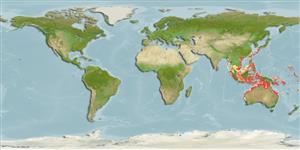>
Eupercaria/misc (Various families in series Eupercaria) >
Labridae (Wrasses) > Corinae
Etymology: Coris: Greek, kore, -es = pupil and also with themenaing of "maid" (Ref. 45335).
More on authors: Randall & Kuiter.
Environment: milieu / climate zone / depth range / distribution range
Ecologia
marino associati a barriera corallina; distribuzione batimetrica 9 - 55 m (Ref. 90102). Tropical
Western Pacific: Philippines, Indonesia, and Australia (including Western Australia). Reported from Taiwan (Ref. 5193).
Size / Peso / Age
Maturity: Lm ? range ? - ? cm
Max length : 15.0 cm TL maschio/sesso non determinato; (Ref. 2272)
Spine dorsali (totale) : 9; Raggi dorsali molli (totale) : 12; Spine anali: 3; Raggi anali molli: 12; Vertebre: 25. Body whitish; a broad black stripe from snout through eye, ending in upper central part of caudal fin, this stripe separated by a narrow white band from a mid dorsal black stripe. Iris yellowish. Male with yellow border on the lower edge of lateral black stripe; basal blackish band of dorsal fin tinged with red instead of yellow; anal fin darker yellow; caudal tinged with light red basally on lobe instead of bluish white. 6 branchiostegal rays. Fin spines pungent.
Common around small coral heads in silty sand-rubble areas. Generally found at depths of more than 20 m (Ref. 33411). Occurs in small groups on sandy or muddy substrates along reef margins or on soft bottom. Enters shallow estuaries as well (Ref. 48636).
Life cycle and mating behavior
Maturities | Riproduzione | Spawnings | Egg(s) | Fecundities | Larve
Oviparous, distinct pairing during breeding (Ref. 205).
Randall, J.E., 1999. Revision of the Indo-Pacific labrid fishes of the genus Coris, with descriptions of five new species. Indo-Pac. Fish. (29):74 p. (Ref. 33411)
IUCN Red List Status (Ref. 130435)
Threat to humans
Harmless
Human uses
Pesca: commerciale; Acquario: Commerciale
Strumenti
Special reports
Download XML
Fonti Internet
Estimates based on models
Preferred temperature (Ref.
123201): 24.6 - 28.9, mean 27.6 °C (based on 432 cells).
Phylogenetic diversity index (Ref.
82804): PD
50 = 0.5000 [Uniqueness, from 0.5 = low to 2.0 = high].
Bayesian length-weight: a=0.00977 (0.00470 - 0.02030), b=3.07 (2.89 - 3.25), in cm total length, based on LWR estimates for this (Sub)family-body shape (Ref.
93245).
Trophic level (Ref.
69278): 3.4 ±0.3 se; based on size and trophs of closest relatives
Resilienza (Ref.
120179): Alto, tempo minimo di raddoppiamento della popolazione meno di 15 mesi (Preliminary K or Fecundity.).
Fishing Vulnerability (Ref.
59153): Low vulnerability (10 of 100).
Nutrients (Ref.
124155): Calcium = 67.6 [25.7, 196.1] mg/100g; Iron = 0.717 [0.421, 1.315] mg/100g; Protein = 18.5 [15.6, 20.6] %; Omega3 = 0.157 [0.075, 0.319] g/100g; Selenium = 28.6 [10.7, 83.5] μg/100g; VitaminA = 144 [44, 534] μg/100g; Zinc = 2.36 [1.07, 4.29] mg/100g (wet weight);
